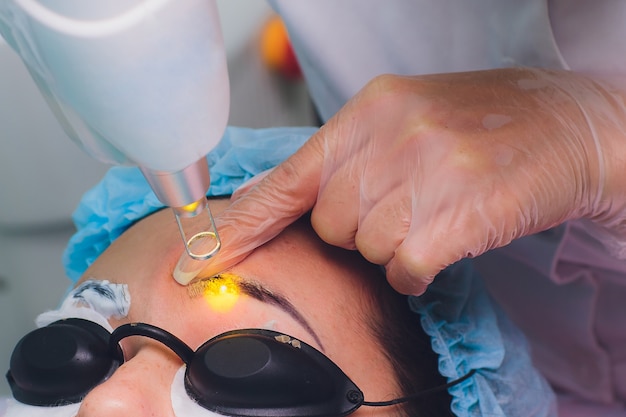IgG4-related cutaneous plasmacytosis has seen increasing recognition as a distinct clinical manifestation within the broader spectrum of IgG4-related disease. This detailed research led by Makoto Inaoki, along with Chihiro Nishijima, Kiyoki Kitagawa, Takeshi Echigo, Kazuyoshi Katayanagi, and Kiyohiro Tsutsui, explores the intriguing development of IgG4-related cutaneous plasmacy during the progression of cutaneous plasmacytosis. As a relatively new clinico-pathological entity, IgG4-related disease is characterized by its unique histopathological features and a likely autoimmune mechanism, although its etiology remains enigmatic.
In this examination, the team delves into the characterizations, implications, and potential interventions associated with IgG4-related cutaneous plasmacy. By scrutinizing detailed patient case studies and engaging comprehensive diagnostic processes, this study endeavors to broaden the clinical understanding of how IgG4-related disease can manifest on the skin layer, thereby enhancing the diagnostic accuracy and therapeutic approaches. This research not only propels forward our understanding of IgG4-related conditions but also paves the way for more targeted treatments that address specific manifestations of this complex disease spectrum within dermatological practices.
## Background and Context of Research on IgG4-Related Cutaneous Plasmacy
IgG4-related disease (IgG4-RD) represents a challenging enigma in the medical field, recognized by its distinct immunological and histopathological features. Marked by a high level of serum IgG4 and infiltration of IgG4-positive plasma cells in various organs, the disease has been studied across multiple disciplines. However, the dermatological implications, particularly IgG4-related cutaneous plasmacy, have only recently come into the spotlight, meriting deeper investigation.
This research led by Makoto Inaoki and team aims to dissect the nuances of IgG4-related cutaneous plasmacy, a manifestation of the disease that involves the skin. Cutaneous plasmacytosis has been observed in various patient demographics and often presents a diagnostic challenge due to its rarity and nonspecific presentation. Symptoms typically involve multiple hyperpigmented macules and plaques, predominantly affecting the trunk and proximal extremities, with a notable absence of pruritus or other significant discomfort.
The potential autoimmune basis of IgG4-RD suggests a complex etiology involving genetic, environmental, and immunological factors. The disease’s tendency to affect multiple organ systems can lead to a wide range of clinical presentations, thereby complicating its diagnosis and management. In dermatology, the specificity of skin-related symptoms and their correlation with systemic manifestations are crucial for adequate diagnosis. This emphasizes the need for comprehensive dermatological assessment alongside systemic evaluations.
With IgG4-related cutaneous plasmacy being a relatively recent classification, much of the existing literature has focused on systemic IgG4-RD without comprehensive attention to cutaneous symptoms. Previous studies have highlighted the importance of recognizing specific histopathological patterns in biopsy samples from affected skin, such as storiform fibrosis and obliterative phlebitis, which are also seen in other manifestations of the disease.
The inclusion of detailed patient case studies in this research enables a more nuanced analysis of clinical progression and response to treatment, providing insights into the peculiarities of the disease when it presents primarily or significantly on the skin. This direction in research is crucial as it explores targeted therapeutic interventions that could better manage or potentially reverse the skin manifestations of IgG4-RD.
Through expanding the scope of research and clinical knowledge, Inaoki and his team hope to contribute robustly to the field, improving diagnostic accuracy for IgG4-related cutaneous plasmacy and refining therapeutic strategies to alleviate the burden of this complex autoimmune disease. The ultimate goal is to ensure better patient outcomes through more precise and informed medical practice, tailored to the unique challenges posed by IgG4-RD within dermatology.
### Methodology of Research on IgG4-Related Cutaneous Plasmacy
The research methodology employed by Makoto Inaoki and the team to study IgG4-related cutaneous plasmacy involves a multi-faceted approach, drawing from a variety of diagnostic tools and investigative techniques to ensure comprehensive insight and robust conclusions. This methodology aims to dissect the complex interactions within IgG4-related disease, particularly focusing on its presentation as cutaneous plasmacytosis.
#### Patient Selection and Data Collection
The initial phase involves the careful selection of patients who have been diagnosed with or exhibit symptoms suggestive of IgG4-related cutaneous plasmacy. The patient cohort is composed of individuals from diverse demographics to assess the disease’s impact across different age groups, genders, and racial backgrounds. Detailed medical histories are collected along with current symptoms, previous treatments, and outcomes.
#### Diagnostic Testing
Key to the study is a rigorous diagnostic regimen that includes blood tests to measure serum IgG4 levels and a comprehensive series of imaging studies to exclude or confirm systemic involvement. Skin biopsies are performed on all patients exhibiting dermal manifestations consistent with IgG4-related cutaneous plasmacy. These biopsy samples are subjected to a meticulous histopathological examination to identify characteristic features such as storiform fibrosis and obliterative phlebitis, which would corroborate a diagnosis of IgG4-RD.
#### Case Study Review
In-depth case reviews form a critical part of the methodology, where each patient’s clinical progression, response to past treatments, and histological data are analyzed. These case studies help illustrate unique or common patterns in the manifestation of IgG4-related cutaneous plasmacy, contributing significantly to the understanding of disease mechanisms and effectiveness of various treatment protocols.
#### Interventional Study
Selected patients are enrolled in an interventional study where new or existing therapeutic approaches specifically tailored to manage IgG4-related cutaneous plasmacy are applied. The response to these treatments is rigorously monitored through regular follow-ups involving clinical assessment and repeat biopsies when necessary. This part of the study is crucial for evaluating the efficacy of targeted therapies in managing cutaneous manifestations of IgG4-RD.
#### Data Analysis and Reporting
The data collected from diagnostic tests, case studies, and the interventional study are analyzed using statistical software to identify patterns and outcomes. The effectiveness of different treatments is assessed, and potential correlations between demographic factors and disease severity or response to treatment are explored.
The comprehensive methodology employed in studying IgG4-related cutaneous plasmacy not only aims to enhance the understanding of this complex disease manifestation but also seeks to develop more effective and personalized treatment strategies. Through rigorous research and detailed case studies, the team led by Makoto Inaoki is enabling significant strides in the field of dermatology, particularly in managing and understanding IgG4-related diseases.
### Key Findings and Results of Research on IgG4-Related Cutaneous Plasmacy
The research conducted by Makoto Inaoki and his colleagues on IgG4-related cutaneous plasmacy provided significant insights into the clinical, histopathological, and therapeutic aspects of this disease manifestation. The comprehensive examination of patient cases, diagnostic evaluations, and interventional studies led to several critical findings that enhance the understanding and management of this complex condition.
#### Clinical Presentation and Histopathology
One of the primary outcomes demonstrated that IgG4-related cutaneous plasmacy often presents with multiple hyperpigmented macules and plaques, confirming earlier descriptions of its nonspecific dermatological appearance. This appearance complicates its differentiation from other dermatological conditions without specific testing and awareness of the disease. Histopathologically, the study confirmed the presence of infiltrates predominantly consisting of IgG4-positive plasma cells and highlighted the importance of specific features such as storiform fibrosis and obliterative phlebitis. These features were crucial in distinguishing IgG4-related cutaneous plasmacy from other types of skin-related plasmacytosis and non-IgG4-related dermatological disorders.
#### Serum IgG4 and Systemic Involvement
Elevated serum IgG4 levels were observed in a significant proportion of the studied patients, which correlated with the intensity of skin manifestations in some cases. However, the research also uncovered that elevated serum levels alone were not sufficient for diagnosis unless accompanied by the histopathological confirmation in skin biopsies. Furthermore, while some patients exhibited systemic involvement, indicating a multi-organ impact of IgG4-RD, a subset of patients showed isolated cutaneous presentations, which suggests varying degrees of disease manifestations.
#### Treatment Efficacy and Patient Outcomes
The intervention studies provided pivotal insights into the effectiveness of targeted therapies. Treatments that modulated immune responses, such as corticosteroids and rituximab, showed promising results in reducing dermatological symptoms and serum IgG4 levels. The responsiveness to these therapies underscored the likely autoimmune mechanism underlying IgG4-related cutaneous plasmacy, supporting the use of immunomodulatory treatment strategies.
Moreover, through the analysis of long-term treatment outcomes, the research highlighted that sustained immunotherapy could potentially lead to remission or significant reduction in disease activity. This finding emphasizes the potential for chronic management strategies in severely affected patients.
#### Implications for Clinical Practice
Overall, the key findings from Makoto Inaoki’s research team on IgG4-related cutaneous plasmacy importantly influence the clinical approach to diagnosing and treating cutaneous manifestations of IgG4-RD. The necessity for awareness among dermatologists and general practitioners about this condition is critical for early detection and accurate diagnosis, leveraging specific histopathological tests and considering systemic associations of the disease.
The study also points towards the need for a standardized therapeutic protocol tailored for IgG4-related cutaneous plasmacy, incorporating immune-modulating treatments with an understanding of potential side effects and patient-specific factors.
By these contributions, the research enriches the knowledge base surrounding IgG4-RD, supporting more informed, precise, and effective clinical practices and offering hope for improved patient management and outcomes in dealing with this challenging and multifaceted disease.
### Future Directions and Final Thoughts on IgG4-Related Cutaneous Plasmacy
The extensive research spearheaded by Makoto Inaoki and his colleagues brings to the forefront a comprehensive understanding of **IgG4-related cutaneous plasmacy**. Their findings offer crucial insights that not only guide clinical practices but also pave the way for future investigations. Given the puzzle that IgG4-RD still presents to the medical community, especially in its dermatological manifestations, the need for ongoing research is clear.
#### Expanding Research to Other Demographics and Geographies
One potential direction for future research focuses on broadening the scope of study populations to include a wider range of demographic groups and geographic regions. **IgG4-related cutaneous plasmacy** has been described mostly in certain populations, and expanding these studies globally could provide insights into genetic, environmental, or lifestyle factors that may influence disease expression. Such diversity in research can lead to more generalizable findings and tailored treatments catering to specific population needs.
#### Genetic and Molecular Studies
Further genetic and molecular studies could elucidate the underlying mechanisms of IgG4-RD. Identifying specific genes or molecular pathways associated with **IgG4-related cutaneous plasmacy** could lead to the development of novel therapeutic targets and diagnostic markers. With advancements in genetic technology, such as CRISPR and whole-genome sequencing, researchers have tools at their disposal to uncover these potential genetic influences.
#### Longitudinal and Long-term Treatment Studies
Ongoing longitudinal studies monitoring patients over extended periods can provide invaluable data on the long-term efficacy and safety of treatments. These studies will be vital in assessing the sustainability of remission with current therapeutic approaches and in understanding the natural progression of **IgG4-related cutaneous plasmacy** without intervention.
#### Development of Specific Guidelines
Given the complexity and variability of IgG4-RD, specifically the cutaneous manifestations, developing standardized diagnostic and treatment guidelines would be highly beneficial. These guidelines would help unify the approach to **IgG4-related cutaneous plasmacy** across dermatology and rheumatology disciplines, promoting timely and accurate diagnosis and optimal patient management.
#### Enhancing Awareness and Education
Increasing awareness and education about **IgG4-related cutaneous plasmacy** among healthcare professionals is crucial. Enhanced understanding and recognition of this disease will lead to faster diagnoses and prevent potential misdiagnoses. Additionally, patient education programs could assist in managing expectations and improving compliance with treatment regimens, particularly in managing a disease that might require long-term immunomodulatory therapy.
### Final Thoughts
The journey of unfolding the mysteries of **IgG4-related cutaneous plasmacy** is far from over. The comprehensive groundwork laid by the research team led by Makoto Inaoki provides a solid foundation for further exploration and understanding. As research continues to unravel the intricate details of this condition, the hope is that it will lead to more targeted and effective treatments, improving quality of life for those affected by this challenging and enigmatic disease. The collective efforts of researchers, clinicians, and patients moving forward will surely provide new insights and breakthroughs in managing **IgG4-related cutaneous plasmacy** and broader IgG4-related diseases.









